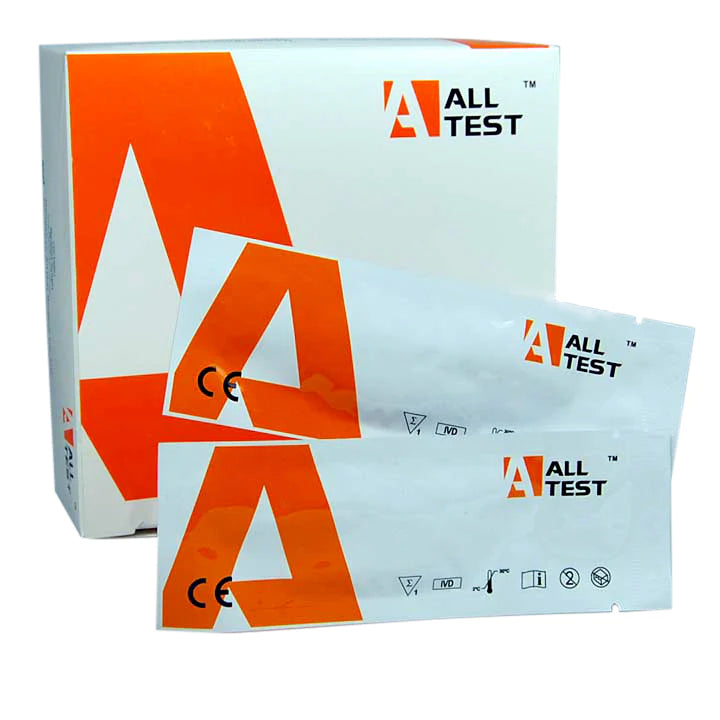ALLTEST
ALLTEST Nitazene Test Strips NTZ Urine Drug Test Strips
ALLTEST Nitazene Test Strips NTZ Urine Drug Test Strips
Couldn't load pickup availability
This Workplace Drug Test Kit Detects
| Name | Drug | Sensitivity | Average Detection Period (Max) |
|---|---|---|---|
| NTZ2000 | Isotonitazene | 2000ng/mL | 48 hours |
| NTZ2000 | Etonitazene | 1000ng/mL | 48 hours |
| NTZ2000 | Metonitazene | 1000ng/mL | 48 hours |
| NTZ2000 | Protonitazene | 1000ng/mL | 48 hours |
Nitazene NTZ 2000ng/mL urine test strips
Nitazene is a powerful synthetic opioid that belongs to the benzimidazole family. It is significantly potent and has been increasingly found on the streets, posing a severe risk due to its high potential for overdose and misuse. Despite its medical applications, Nitazene's presence in illicit markets has prompted the need for reliable detection methods.
What are Nitazene Test Strips and how do they work?
Nitazene test strips are tools designed to detect the presence of Nitazene metabolites in urine samples. These strips are specifically calibrated to identify concentrations of Nitazene at or above 2000ng/mL. By providing a rapid and accurate means of detection, these test strips play a crucial role in both clinical settings and harm reduction efforts.
Key points about ALLTEST Nitazene NTZ Test Strips:
- A rapid and straight forward urine examination for NTZ
- Nitazene test strips with a sensitivity of 2000ng/ml
- The Nitazene test discerns intake for a span of up to 48 hours after the most recent usage.
- Quick and simple to use test strips, providing results for urine within 3-5 minutes.
- Each individual Nitazene test strip is encased in foil for preservation.
- With a remarkable accuracy rate of 99.9%
What is a Nitazene urine test
A nitazene urine test is a type of drug screening designed to detect nitazenes, a relatively new and highly potent group of synthetic opioids.
What nitazenes are:
Nitazenes (such as isotonitazene, metonitazene, etonitazene, etc.) are a class of opioids first developed in the 1950s but never used in medicine because of their extreme potency—often stronger than fentanyl. In recent years, they’ve appeared in the illicit drug supply, sometimes mixed with heroin, fentanyl, or counterfeit pills.
Why Nitrazene urine testing is needed:
Standard drug screens (like routine opiate or fentanyl tests) often do not detect nitazenes. Specialised tests are required to pick them up.
The urine test:
A nitazene urine test works like other toxicology screens but specifically looks for the presence of nitazene compounds and their metabolites in urine. It can be done via immunoassay (quick urine drug screen) and also via confirmatory lab methods.
Uses
- Hospitals and rehab units (to guide treatment in suspected opioid overdose when naloxone doses are unusually high).
- Forensic toxicology (post-mortem or law enforcement cases).
- Specialist drug testing labs for workplace or clinical monitoring in areas where nitazenes are emerging.
Share

Collapsible content
How long can drugs be detected in urine?
The detection window for drugs in urine can vary widely between individuals depending on several factors, including the type of drug, the amount of drug used, the route the drug is administered, the frequency of use, the individual's metabolism, body mass, age, hydration level, and overall health.
Here are some general detection windows for common drugs in urine:
Amphetamines : 1-3 days.
Benzodiazepines (e.g., Valium, Xanax): 3-7 days for occasional use, up to 4-6 weeks for chronic use.
Cannabis (THC): How long Cannabis can be detected in urine very much depends on the amount and frequency of use and the build of the individual. Below is a guide
Single Cannabis use: 1-3 days.
Moderate Cannabis use (4 times/week): 5-7 days.
Chronic Cannabis use (daily): 10-15 days.
Heavy chronic Cannabis use (multiple times/day): 30+ days.
Cocaine: 2-4 days.
Heroin: 2-3 days.
LSD: 1-3 days.
MDMA (Ecstasy): 2-4 days.
Methadone: 3-4 days.
It's important to note that these are general guidelines. Individual results can vary, and certain drug tests may have different sensitivities and cut-off levels that can affect detection times. Additionally, some drugs are metabolised into other compounds that may be detected for different periods.
More information on detection times for drugs in urine and saliva here


